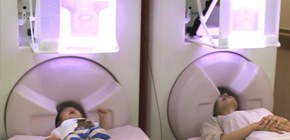
Simultaneous Measurements of Brain Activities with MEG
Discovery of brain activities during face-to-face interactions between mothers and their children with autism spectrum disorder (ASD)
A group of researchers led by Director MINABE Yoshio, Professor KIKUCHI Mitsuru, Postdoctoral Researcher HASEGAWA Chiaki at the Research Center for Child Mental Development, Kanazawa University, together with a group of researchers led by Professor ASADA Minoru at the Graduate School of Engineering, Osaka University, examined brain activities during face-to-face interactions between mothers and their children with autism spectrum disorder (ASD) by using a magnetoencephalography (MEG) system at Kanazawa University.
A custom child-sized magnetoencephalography (MEG) was made in 2008 for measuring children’s brain responses by using a Superconducting Quantum Interference Device (SQUID). This device can measure and analyze children’s neuromagnetic activities without causing damage to their head surface. In 2014, together with Osaka University, Kanazawa University developed a non-invasive MEG recording system, which is capable of simultaneously measuring neuromagnetic activities in both mothers and their children while they are looking at each other in a relaxed state.
This MEG system is capable of directly catching electrical activity of neurons and has excellent temporal resolution (milliseconds) and spatial resolution, so it shows promise for evaluation of brain networks. In addition, this MEG system neither uses radiation nor makes a loud noise, and what's more, it does not require the subject to be put into a narrow space, so it’s helpful in examining brain activities during childhood.
This is the first medical report on research using this device, clarifying the following three points:
- 1. Brain responses produced by looking at each other, which is called "mu suppression" and is generated during mother-child face-to-face interactions, were reduced in children with more severe ASD.
- 2. When brain responses in children with ASD were reduced, their mothers’ brain responses were also reduced.
- 3. If mothers nodded in accordance to their children during face-to-face interactions, these mothers’ brains responded strongly.
During parent-child face-to-face interactions, a large amount of social information is exchanged between the two at an unconscious level. One understands the emotions of the other through his or her facial expressions, and new emotions are produced and presented as facial expression in the former, which affects the latter. In this way, interactive information exchange is conducted continuously.
It is thought that interactive exchange during parent-child face-to-face interactions plays an important role in the social development of children. Simultaneous recording of brain activities in a live face-to-face state can become a step toward the understanding of social development of children.
Please note that this study does not show that parents’ involvement in child-rearing causes ASD.
Abstract
Spontaneous face-to-face interactions between mothers and their children play crucial roles in the development of social minds; however, these inter-brain dynamics are still unclear. In this pilot study, we measured MEG mu suppression during face-to-face spontaneous non-linguistic interactions between mothers and their children with autism spectrum disorder (ASD) using the MEG hyperscanning system (i.e., simultaneous recording). The results demonstrated significant correlations between the index of mu suppression (IMS) in the right precentral area and the traits (or severity) of ASD in 13 mothers and 8 children (MEG data from 5 of the children could not be obtained due to motion noise). In addition, higher IMS values (i.e., strong mu suppression) in mothers were associated with higher IMS values in their children. To evaluate the behavioral contingency between mothers and their children, we calculated cross correlations between the magnitude of the mother and child head-motion during MEG recordings. As a result, in mothers whose head motions tended to follow her child’s head motion, the magnitudes of mu suppression in the mother’s precentral area were large. Further studies with larger sample sizes, including typically developing children, are necessary to generalize this result to typical interactions between mothers and their children.

Figure 1 . The special MEG used in this study can detect electrical activities of the brain of an adult and that of a child. (The child in this picture does not suffer from autism spectrum disorder.)

Figure 2
To learn more about this research, please view the full research report entitled “ Mu rhythm suppression reflects mother-child face-to-face interactions: a pilotstudy with MEG simultaneous recording ” at this page of the Scientific Reports website.
Related links

